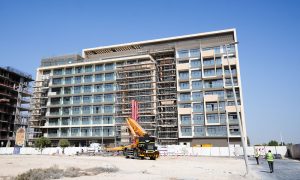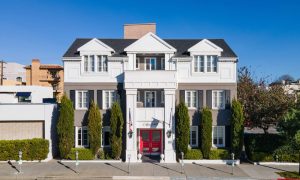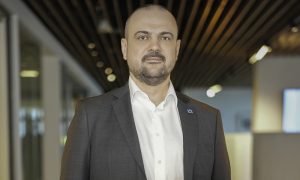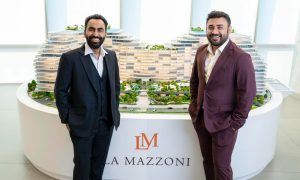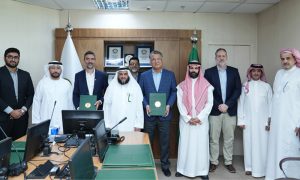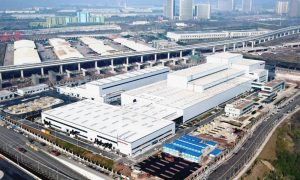Building a sustainable framework for the Middle East
Based upon a round table discussion attended by speakers from Infrastructure ARABIA Summit, a four-day conference taking place alongside WORLD ecoConstruct, 22-25 April, Abu Dhabi National Exhibition Centre, this White Paper examines the opportunities and challenges facing the infrastructure industry in the Middle East in the wake of economic and political turmoil. Moderator: Melanie Mingas, […]
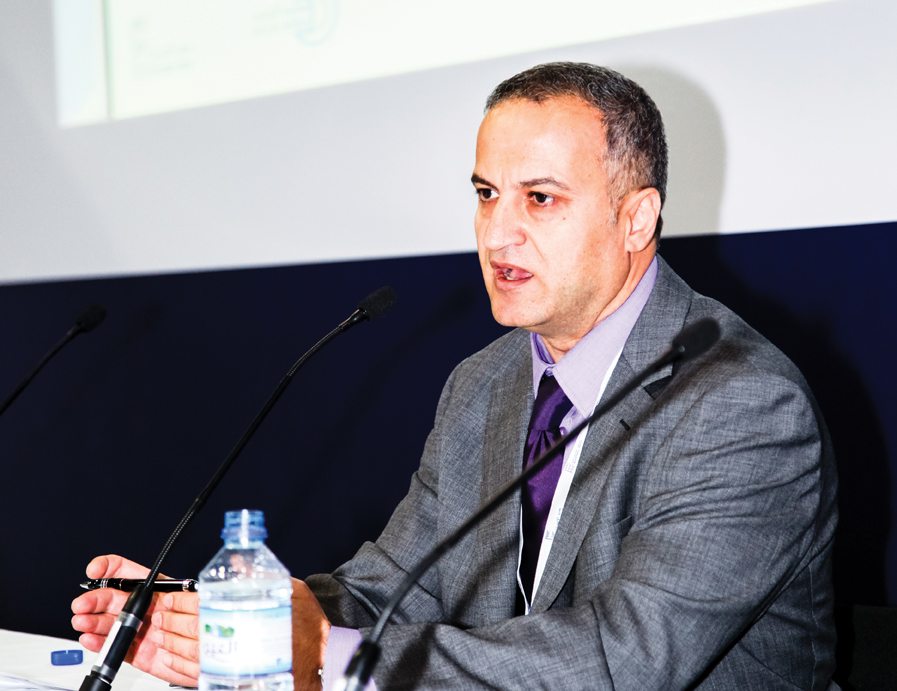
Based upon a round table discussion attended by speakers from Infrastructure ARABIA Summit, a four-day conference taking place alongside WORLD ecoConstruct, 22-25 April, Abu Dhabi National Exhibition Centre, this White Paper examines the opportunities and challenges facing the infrastructure industry in the Middle East in the wake of economic and political turmoil.
Moderator:
Melanie Mingas, Head of Editorial, The Big Project
Participants:
Matthew Plumbridge, Consultant, Environment and Sustainability Planning, Department of Municipal Affairs, Abu Dhabi
Ivan Woods, Head of Project Finance Advisory, BDO Corporate Finance (Middle East) LLP
Dr Ghassan Ziadat, Director of Infrastructure (UAE) and Regional Head of Bridges, Middle East and India, Atkins
Organised by Informa Exhibitions
Introduction
Despite the turmoil that has swept across the Middle East in the past year, infrastructure projects worth billions of dollars have featured high on the agenda of most countries in the region.
According to the latest figures from research firm Ventures Middle East, the total value of infrastructure projects in the GCC stands at $408.8bn. While many industry experts now point to Saudi Arabia and Qatar as the two GCC states offering the most opportunity in infrastructure and construction at wide, the UAE still holds the lion’s share of infrastructure projects, accounting for $187.2bn. Abu Dhabi alone has earmarked $15bn on expansion of infrastructure projects between 2009 and 2012.
Saudi Arabia’s current infrastructure and public spending programme is worth $117.7bn while Qatar is expected to spend more than $60bn on its infrastructure projects ahead of the FIFA World Cup in 2022. Kuwait accounts for $35.5bn worth of infrastructure projects while Oman and Bahrain hold $24.7bn and $12.9bn respectively.
This White Paper has been drafted based upon a round table discussion by Matthew Plumbridge, consultant, Environment and Sustainability Planning, Department of Municipal Affairs (DMA), Abu Dhabi; Ivan Woods, head of Project Finance Advisory, BDO Corporate Finance (Middle East) LLP and Dr Ghassan Ziadat, director of Infrastructure (UAE) and Regional Head of Bridges, Middle East and India, Atkins.
All three participants are speakers at the infrastructure ARABIA Summit, taking place from 22-25 April 2012 at the Abu Dhabi National Exhibition Centre alongside WORLD ecoConstruct and Cityscape Abu Dhabi.
The discussion was moderated by Melanie Mingas, head of Editorial at The Big Project magazine.
The impact of political and economic turmoil
When the world was starting to recover and regroup in the wake of the global economic crises, the Middle East region experienced a wave of political turmoil which has contributed to the challenges being faced across all industries. The construction industry on the whole continues to deal with delays, projects on hold or shelved, while the tender process becomes more rigorous and stringent.
Social infrastructure
In light of the Arab Spring and the seismic shift in global finance opportunities, governments in the region are placing more emphasis on social infrastructure in order to create sustainable communities, job opportunities and comfortable living.
According to Dr Ghassan Ziadat, “the UAE government has responded to make sure social infrastructure was adequate for the population, and the people are satisfied with the level of education and healthcare they receive.
One reason social infrastructure has become more of a priority is because finance for typically smaller projects is relatively easier to source. Ivan Woods points to the availability of local financing reducing reliance on large international banks, which in many cases remain capital constrained. He said, “In a more general sense, there is recognition that as a result of the Arab Spring, more of these social infrastructure projects are required and people are looking to their governments to meet these needs.
“Social infrastructure has been less well served [in recent years] than the big power and water projects.”
Sustainable workforces
Yet, a result of political turmoil is the talent gap. While the UAE remains relatively unscathed by the Arab Spring, many skilled expatriate workers have left the region, specifically Libya, Bahrain and Egypt, which once again draws a spotlight on the region’s reliance on international, skilled workers employed in order to fulfil projects’ needs.
A large proportion of local talent in the Middle East is young people. Dr Ziadat said, “The other large implication is for the young people in the region; about half the population is under the age of 16. One of the main concerns is that there aren’t enough jobs to go around and so unemployment is high on the agenda. Creating jobs for the young population has become a real priority.”
Woods added, “For project construction, reliance on expatriate workers may not be such an issue – but for infrastructure projects which will run for 30 or even 50 years, the local workforce should be incentivised to take over operations and to manage the project going forward.”
City versus rural living
The ratio of people living in cities to those living in rural areas is approximately 4 to 1, according to Dr Ziadat. “It is a misconception that in the Middle East, people are still living basic lifestyles in rural areas. Across the region, actually about 80% of the population lives in cities and this in itself creates challenges.
“If you plan infrastructure to create new jobs, you may be solving one problem and creating another. In Abu Dhabi, and across the region, there is significant migration from the rural areas to the cities which puts pressure on the built environment of that city.
“By leaving the rural areas, we deprive them of the working population and its sustainability in the long term.
“There needs to be investment, not just in the urban population centres but in the rural areas too in order to stem this migration and relieve the pressure on the cities. To achieve that, you need a whole gamut of different measures.
“People don’t mind living in rural areas such as the Western Region of Abu Dhabi, as long as they have the necessary high quality social infrastructure provided – healthcare, housing, jobs and education.
“In addition they must be well-connected with the rest of the country. If they decide to go to the city it should only take them an hour or two in comfortable transport.”
Managed economies
One of the biggest changes witnessed at the turn of the decade, in light of the economic downturn has been a shift to a more managed economy. Dr Ziadat explains, “Two or three years ago, the market was driving things, particularly in the private sector with the property market boom. There was a lot of construction going on to service the private sector and the private investor which created a lot of jobs and economic growth. With the global financial situation, this has slowed down significantly and so the governments are dealing with the fact that the private sector has slowed down.
“Many countries in the region… are trying to steer the economy into growth, create jobs by investing in infrastructure, which is a good thing for the industry but the type of construction has now changed quite dramatically in the last few years with more emphasis on wider infrastructure than the high-end property type of construction.”
Woods agrees, and states, “The shift can only be a good one for the foreseeable future – the property bubble was clearly unsustainable, and in the short term governments are surely right to steer their economies to more sustainable sectors.”
Today’s Middle East landscape
Dr Ziadat and Plumbridge use examples outside of the Middle East from which the region can learn when dealing with economically and politically challenging times. Now is the time, they believe, for governments in the region to spend and intervene to keep the ‘bicycle’ moving, from both an economic and psychological point of view.
Public spending injections
Dr Ziadat identifies the Far East – citing countries such as Singapore, Malaysia and Hong Kong – which take advantage of slow cycles in construction. He said, “When the economy is booming and the private sector is healthy and strong, [the governments] slow down on public expenditure to prevent the economy from overheating.
“But when the economy slows down, they want to prevent the economy from shrinking, so they invest by public spending into infrastructure. They get much better value for their money in upgrading the infrastructure when the market prices are more competitive, they invest in the economy and the public spending on infrastructure maintains job creation and keeps things going.”
Plumbridge said, “This has been the case historically. The Hoover Dam helped America out of the Great Depression and today we see Obama’s government look at infrastructure projects as critical to economic recovery.”
“In Australia, during the down times, Contractors will tender on low margins, but they make their money in between payments that they receive and then pay to the sub-contractors. So they invest in the short-term money market and the little amount they eke out keeps them afloat.”
Woods also says that, “Governments often see infrastructure spending as a good way to help an economy out of a downswing.
“While this should still involve the private sector as much as possible, countries across the globe are increasing public investment on needed infrastructure – even with the austerity measures many are enforcing – to boost employment and give a long-term stimulus to their economies.”
Regulation codes
With sustainability now on every business and governmental agenda, cynics question the viability of implementation. Plumbridge points to the energy code currently being phased into the industry in Abu Dhabi as the ‘best in class’. He said, “We will hit the UN Green Building targets for ‘extremely hot climates’. If the UN gives you a target and you achieve that, you’re doing pretty well as a minimum standard.”
Dr Ziadat believes achieving the water balance in the sustainable design phase is an important factor. “If you look at the overall picture in terms of carbon emissions on the sustainability agenda, the majority are water, electricity and energy related. Cutting down the demand for water electricity, heating, cooling and making optimal use of water recycling is vital to achieving the carbon emission targets set in Copenhagen.
“Each country and geography has been set targets and they have signed up to achieving those targets by 2020. In terms of annual carbon emissions per capita, the USA is one of the largest at about 30 carbon tonnes per year per person, which is similar to the UAE’s carbon emissions.
“Everyone in the world realises something needs to be done about it. The UAE is committed to driving down carbon emissions and introducing sustainability initiatives such as Estidama and the model city in MASDAR. The Estidama programme goes a long way towards setting a benchmark to encouraging people to design sustainable buildings and communities.”
Plumbridge reiterated that Estidama is a rating system under which a robust set of regulations is needed.
Understanding the codes and the way they are applied to your region is vital, says Dr Ziadat, in being able to create designs at tender which can stand up against the sustainable agenda and save money. “You could, with good design, save about 20 per cent of construction materials in a project.
“Integrating design and construction through the Design-and-Build collaborative approach can also be a catalyst to innovate and produce more buildable and cost-effective infrastructure.
“I think the market here is still fairly conservative and people have been traditionally suspicious of the construction industry I think it’s reached the stage now where it needs a re-look. The quality of construction on some projects in the UAE now is absolutely world class and this is a good reflection on the capability and professionalism of the developers, consultants and contractors in the region.”
Plumbridge points to the Burj Khalifa as a ‘feat in engineering’ and believes the UAE must play to its strengths – the speed and rate of construction while moving towards more modern methods of construction such as modular, pre-fabrication, pre-casting and using prototypes more often in order to increase worker health and safety and reduce waste.
Urban Planning
Today, the focus in Abu Dhabi is to create a cohesive city where people can comfortably live, work and raise families; addressing the fact that living in an extremely hot climate plays an important role in achieving that.
One of the aims of the landscape strategy currently being compiled by the DMA is to create continuous pedestrian and cycling networks throughout the UAE capital but when the sun’s influence affects your daily movements this is especially challenging. Plumbridge believes we can learn from ancient cities in Morocco and Egypt in which passive breezes are maintained and the overall objective is to keep the sun off everything. “Urban planning [in this region] is driven by sun and breeze,” he said.
This form of natural cooling is essential, according to Dr Ziadat. “For cities to be more sustainable it makes sense for the buildings to be closer together and in a dense environment so people can walk from one tower to another. This dense environment is going to be the future across the globe for city planning.”
Woods is also encouraged that “new developments such as Masdar have integrated traditional techniques from the region (such as use of shading and wind) with modern technology” and believes that such sustainable planning models will only become more important going forward in the region.
And cultural and leisure infrastructure is also important to recognise. “Once the hard infrastructure is there, where basic needs are met, people don’t want to be bored spending all their free time at home; they want to be outside and they want to live in cities that are exciting and interesting.
“The government is investing in culture, such as museums, water parks and attractions like Ferrari World and the value of these destinations should not be underestimated.”
It is expected that this cultural investment will help curb the transient nature of the UAE and contribute to retaining talent. Plumbridge said, “The Municipal System is looking at social responsibility, promulgating areas such as volunteerism, getting to know your neighbours etc. “
Financing mega projects
In relative terms, the UAE and other GCC states such as Saudi Arabia and Qatar are wealthy nations rich in resources and are not as dependent on foreign investment as other countries. The increase in the number of mega projects in the region, however, does shine the spotlight on capital finance and the introduction of public-private partnerships (PPPs).
The number and scale of large infrastructure projects currently being developed in the UAE, such as the Step Tunnel, MASDAR City, the new energy and power and desalination stations, the nuclear programme and the number of transportation programmes from roads and railways, port and airport expansions to bus stations and depots, create financial constraints.
Dr Ziadat believes that the region must pull together in order to survive and PPPs need to be considered, especially in less wealthy nations. “The majority of countries in the Middle East may well need to on foreign direct investment and private sector investment to achieve their development programmes. The wealthy countries in the region are playing a part; they are investing and helping their neighbours, which is essential for the region’s stability, but involving the private sector and bringing in foreign direct investment is a must, it has to happen.”
Woods points to countries like Kuwait and Egypt which have successfully utilised PPPs but warns that many countries come across issues when getting these projects started, largely due to complications in developing new financial models and fully understanding the requirements of a PPP project.
He believes, “PPPs can be of great benefit, particularly to maximise the private sector’s involvement and added value. The challenges of implementing a PPP properly, however, and ensuring value for money for the government and the wider public, must be addressed upfront. In some cases projects have fallen over because initial plans weren’t well thought through – look at the Mafraq-Gweihat highway.”
Woods says that financing remains a challenge given global economic concerns, although for good projects funding should still be available and the region is generally seen as a relatively safe investment opportunity.
Transparency, says Plumbridge, is the key to attracting foreign investment and the genesis of the PPP model is to provide critical infrastructure.
The adoption of the PPP model is growing in Abu Dhabi; Plumbridge highlights both a sewerage infrastructure project and a crushed rock, recycled concrete aggregate facility which are being constructed in collaboration with the private sector.
Aside from financial constraints, one of the biggest challenges in delivering mega projects in the region is finding the human resources and skilled labour. “The boom time happened here [in the UAE] and now it’s in Qatar and Saudi Arabia,” said Plumbridge. “If you want to do a mega project now, the resource pool has moved so you might have to bring in people who don’t necessarily know or appreciate how the UAE operates.”
Underserved areas in infrastructure
Woods believes that the region still has some way to go before the needed level of infrastructure is available. “There are significant shortfalls in a number of areas,” he said. “Affordable housing has not been made available in sufficient quantity and this has been recognised in Saudi Arabia, Bahrain and Oman.”
Given increasing demand for improved social services such as health and education, as well as needed improvements to transport links and the continuing need for clean water and power, he emphasises, “it’s a long list”.
And while Woods believe power projects have been developed more successfully than housing in the region, Dr Ziadat points to the energy sector as the still most important infrastructure factor in the Middle East, particularly as they relate to water projects because of the lack of natural resources. He explained, “Jordan only has water supplied to its population once a week for a few hours. It is the poorest country in terms of water in the world and it has a growing population and no financial resources to address the situation.
“Energy, water and environment are all related in this region: you need energy to desalinate the water and you can’t create energy to desalinate without affecting the environment. The UAE is very fortunate with its hydrocarbon reserves and is trying to diversify its energy supplies through the nuclear programme and through renewable solar and wind power. If you have adequate and renewable energy supplies, the water issues can be solved.”
Plumbridge refers to Abu Dhabi’s Critical National Infrastructure Authority which is driving programmes such as aquifer storage, which will see the amount of desalinated water in storage increase from three to four days’ worth to two months’ worth, in light of an unforeseen circumstance or natural disaster. “If you take out the water and you take out the power, you don’t last so long,” he said.
Conclusion
The Middle East is facing an opportunity now, in light of the global financial crisis and the Arab Spring. The pressure on the construction industry at large and specifically infrastructure professionals is different to the overwhelming urgency and speed expected in the mid-2000s. Dr Ziadat believes now is the time to take stock, evaluate and identify how the industry can work more efficiently and provide an even better quality service to the population and environment into the future.
“The private sector is so focussed on short term return on investment and so now, those pressures have lessened,” he said. “The government-driven properly planned long –term programmes can look at implementation of sustainable policies taking advantage of recycling, efficiency, modular construction, how to improve in the long run and how to attract long term sustainable investments such as pension funds into infrastructure this is where you can move from being a developing country to the next step up.
“Becoming more sustainable by design is an urgent issue which needs to be addressed but it is a journey you have to go through which cannot be simply introduced overnight.”
Railways
One key area of opportunity and growth for the Middle East is the rail industry, according to Dr Ziadat. He believes the region is poorer off for the lack of an inter-nation railway infrastructure and that the Middle East was ‘left behind’ in the railway transportation age. He asks, can you imagine Europe without a proper rail network?
“I think for sustainability in transportation, [rail] is the future; it is currently more sustainable than air and road travel. Railway transportation is much more sustainable in terms of carbon emissions but you need to have a long term investment programme to achieve it and build a whole industry around it. You need to support the operation and the maintenance of it, the safety, security and the technological aspects. It would really help to connect and integrate the economies here and in the region in ways other than roads, sea and air transport.
“In Europe, inter-trade is around 60 per cent of the gross national product; in the Middle
East it is far lower partly because of limitations on efficient rail transportation links. Rail has been left behind over the years because it is quicker to build roads and import cars, but as governments look for medium to long term gains, it is a good investment, it creates healthier environments and makes the economies more sustainable.”
Woods fully supports Dr Ziadat and says, “The region would be very well served with a rail network, both economically and environmentally. This should continue to be a priority for regional governments as the benefits should substantially outweigh the costs over the long term.”
Human resources
One of the biggest challenges reiterated throughout the round table discussion was the need to retain skilled workers and reduce the amount of talent leaving the region. A direct impact of the economic downturn, many expatriate workers lost jobs and returned to their home countries or moved to other emerging markets throughout Africa and Asia.
Dr Ziadat believes that the implementation of GCC-wide working permits would help to curb that trend and retain skills by providing better mobility and flexibility for workers. “At times you’ll have a boom in Saudi and a quiet time in Bahrain or Qatar. Moving to a regional work system would allow the skilled workers and labour to move freely between the GCC countries and thus maintain stability and create flexibility. The cycles in different countries don’t always happen at the same time.”
“The suggestion of implementing a GCC-wide working permit could be expedited because otherwise, these projects will have constraints”.
Creating a legacy
By committing to a more sustainable workforce, Plumbridge believes we take a step closer to engendering a sense of legacy in the region. He calls for professionals in infrastructure to increase their levels of pride and job satisfaction, echoing the achievements from their home nations.
“Your building is your legacy and the legacy of your company and of Sheikh Zayed and his vision, and thus we have to consider the quality of our work as the core in what we do and to have pride in every nut and bolt we put in place. Be prepared to put quality and safety first because that is what you do in your home town and it shouldn’t be any different here.”
